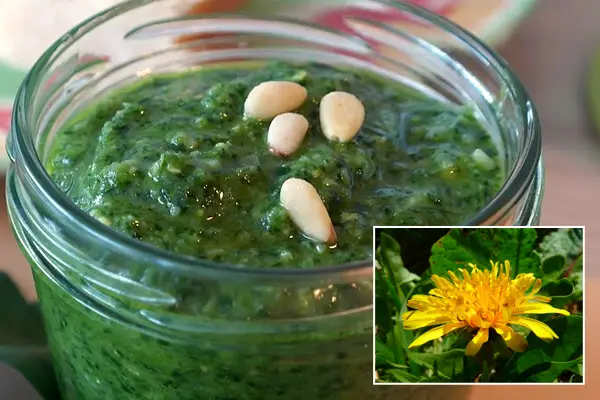
It’s that time of the year, when lively little yellow flowers are popping up on the lawns all over the country. While many see it as “just a weed,” dandelions are one of nature’s gift to men – virtually the whole plant is edible and medicinal.
Dandelion is rich in vitamins A, B, C, and D, and many minerals.
Ounce-for-ounce, dandelion tea has more calcium than milk.
It’s loaded with mineral salts that quickly alkalize acidic blood, and are readily absorbed by the body.
Dandelion flowers are used to make tea, and even some types of herbal wine. The leaves are beneficial for getting rid of excess fluids in the body. Dandelion roots are the most medicinal part of the plant, and are traditionally used for liver and gallbladder problems.
The only part that most don’t use is the stem. It’s not inedible; it’s just not very good.
And just recently scientists discovered that it has great anti-cancerous properties. Dandelion’s health benefits are vast and truly remarkable for such a common plant.
Dandelion’s Amazing Health Benefits
Dandelion has been used medicinally for thousands of years in Chinese medicine, in Europe, and by Native American cultures. Today, it is widely used by complementary and alternative medicine, and the medical field is slowly catching up to its abundance of uses for:
Appendicitis
Appetite stimulant
Blood sugar problems
Breastfeeding aid
Caffeine substitution
Cholesterol problems
Constipation
Diabetes
Diarrhea
Digestive issues
Eye problems
Fever
Gallbladder problems
Heartburn
High blood pressure
Immune system support
Inflammation
Kidney disease
Skin problems
Swelling
Tumors
Upset stomach
A list of 98 medicinal studies of dandelion or Taraxacum officinale is available from the National Institute of Health.
******
Spray this Magnesium and Watch How Your Body Responds!
Purified to the Highest Grade Imaginable…
Spray This Magnesium Spray Before Bed – Your Sleep Will Change Instantly
Learn More Or Try It – Here
*******
How to Gather and Prepare Dandelions

Dandelion leaves are often available fresh in grocery stores and at farmers markets. The roots are being sold in supplement form, and as tea. But if you would like to gather this plant yourself, it is easy to do so.
The only major rule when gathering dandelion is make sure the plant has not be sprayed by chemicals. Go out in nature where the fields have not been sprayed, and gather it there.
Dandelion leaves taste the best when gathered during cool and moist, early spring, and again in the fall. At these times the leaves are less bitter and more tender and sweet. It’s the direct sun that makes them bitter. The best time of day to gather them is early in the morning.
When the plant begins to flower, the leaves become drier, and not as good. But at this time, the yellow flowers are easily picked up at that time. They are hard to wash though, so collect the ones that are free of dust and soil.
The root can be dug up using a simple hang-digging tool. The best time of year to do so is fall, when the plant is becoming dormant, and has gathered a build-up of energy inside of it. In the fall, the root also has the lowest levels of fructose, and the highest levels of insoluble fiber.
After gathering your plant material, there are plenty of things you can do with it.
The leaves are easily washed by soaking them overnight in cold water, then rinsing in the morning (some also wash it with vinegar to kill any lingering bacteria). Fresh leaves can be used in salads or sautéed. The flowers can also be used in salads.
The roots should be scrubbed clean, and cut into strips of the same thickness for uniform drying. A dehydrator may be used at 95 F temperature, or if dried in a cool location, it will take up to 14 days. Once dried, the roots are good for a year. To make a coffee substitute, the roots are roasted for 30 minutes at 400 F.
Dandelion plant preparation is dependent on what you plan to use it for, and there are many recipes to try.
*******
Big Sale For Earth Day!
Find the Best Deals – Here
Beef Sticks, Chicken Sticks…All Fermented and Delicious (Pasture-Raised)
Stock Up For Your Camping Trips – Here
*******
Dandelion Cooking Recipes

Most recipes use dandelion greens, but some incorporate roots, and flowers as well.
The greens are used either fresh or cooked in salads, soups, and vegetable dishes:
Dandelion Greens with Garlic
Spring Green Pizza
Dandelion and Potato Salad
The roots can be used for drinks:
Dandelion “coffee”
Dandelion tea
The flowers are famous for wine, and have other uses as well:
Dandelion wine
Dandelion Jelly
Dandelion Cookies
There also more unusual but easy recipes to surprise your dinner guests with. One such recipe is dandelion pesto.
Dandelion Pesto
The slight bitterness of dandelion greens mixed together with sweet pine nuts and zesty lemon gives pesto a one-of-a-kind flavor. This recipe is nutritious, and healthy for the heart, as well as an anti-inflammatory.
There are many different combinations of this recipe, and it is fun to experiment with its ingredients.

This one is taken from 2017’s Alchemy of Herbs: Transform Everyday Ingredients into Foods and Remedies That Heal by Rosalee de la Forêt.
Ingredients:
½ cup pine nuts
3 garlic cloves
2 cups dandelion leaves
1 Tbsp lemon juice
1 Tbst lemon zest
½ cup olive oil
½ tsp sea salt
1 tsp turmeric powder
½ tsp black papper
¼ cup Parmesan (can be substituted with vegan cheese)
All of the ingredients are blended together until smooth. This pesto can be kept in a fridge for up to 3 days, and is wonderful to serve with crackers, breads, or vegetables.
Watch a quick overview about cooking and using dandelion greens for health in the video below:
Recommended reading:
This is NOT a Weed! This is a Superfood Growing in Your Backyard
50+ Traditional Uses for Lavender You May Not Have Known About
Thanks for installing the Bottom of every post plugin by Corey Salzano. Contact me if you need custom WordPress plugins or website design.




